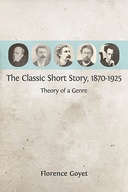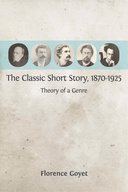Explore
The Classic Short Story, 1870-1925: Theory of a Genre
8 others
I enjoyed reading Florence Goyet's book. I recommend it to you for its breadth and insight.
— Charles E. May, 29 April 2014, review available on Prof. May's blog, at http://may-on-the-short-story.blogspot.co.uk/2014/04/florence-goyet-classic-short-story-1870.html
Florence Goyet's book is remarkable as much for the scope of its corpus (more than a thousand stories in five languages) as for the quality of its analysis. The author defines the short story first by examining its narrative strategies, then by focusing on its print circulation and finally on how the text shapes its own reading. Goyet refines the distinctive features ordinarily accepted by the critics; she then shows that the readers of short stories are always different from the characters depicted, through the specific periodicals in which they are published. This is why the "peasant” stories of Maupassant appear in high society periodicals, and why the "European” stories of Henry James are published in the US, whereas his "American” ones are accepted in English magazines. The primary aim of the genre is to emphasize the picturesqueness of subjects which are a familiar sight for the readers yet in reality strange, because the characters live in another world altogether. Close analysis of this context in which the stories are published leads Goyet to define the genre as "monological” — being at odds with polyphony — a thesis which is confirmed in her subsequent analyses of the stylistic procedures that discredit the characters. Thus, this book provides us with a new understanding of the short text, which is all the more convincing in that it is always rigorously supported by probing theoretical discussions and by precise textual analyses.
— Denis Pernot, Revue d'Histoire Littéraire de la France, XCV/1 (Janvier-Fevrier 1995), p. 127
The ability to construct a nuanced narrative or complex character in the constrained form of the short story has sometimes been seen as the ultimate test of an author's creativity. Yet during the time when the short story was at its most popular - the late nineteenth and early twentieth centuries - even the greatest writers followed strict generic conventions that were far from subtle.
This expanded and updated translation of Florence Goyet's influential La Nouvelle, 1870-1925: Description d'un genre à son apogée (Paris, 1993) is the only study to focus exclusively on this classic period across different continents. Ranging through French, English, Italian, Russian and Japanese writing - particularly the stories of Guy de Maupassant, Henry James, Giovanni Verga, Anton Chekhov and Akutagawa Rūnosuke - Goyet shows that these authors were able to create brilliant and successful short stories using the very simple 'tools of brevity' of that period.
In this challenging and far-reaching study, Goyet looks at classic short stories in the context in which they were read at the time: cheap newspapers and higher-end periodicals. She demonstrates that, despite the apparent intention of these stories to question bourgeois ideals, they mostly affirmed the prejudices of their readers. In doing so, her book forces us to rethink our preconceptions about this 'forgotten' genre.
Open Book Publishers - Setting Knowledge Free
At Open Book Publishers we believe that knowledge is for sharing. We are a non-profit, Open Access publisher, committed to making high-quality research freely available to readers around the world. As well as being published in ebook, paperback and hardback editions, all our books include a free online edition that can be read via our website, downloaded, reused or embedded anywhere. These free online editions are currently being accessed by thousands of readers each month in over 140 countries around the world.
By downloading The Classic Short Story and making a contribution to Open Book Publishers, you are helping us to continue to make high-quality research free for anyone, anywhere to read.
Thank you for your support!
This book is included in DOAB.
Why read this book? Have your say.
You must be logged in to comment.
A Thanks-for-Ungluing Campaign is running to reward the creators of The Classic Short Story, 1870-1925: Theory of a Genre!
The rights holder, Open Book Publishers , has released The Classic Short Story, 1870-1925: Theory of a Genre to the world as a Creative Commons licensed ebook (CC BY) . You can help us say "Thank You!" so that other creators will do the same.
Campaign details: the fine print
Downloads
- 639 - pdf (CC BY) at OAPEN Library.
- 1060 - pdf (CC BY) at Unglue.it.
- 1304 - epub (CC BY) at Unglue.it.
- 1204 - mobi (CC BY) at Unglue.it.
Keywords
- 20th century
- Literary Criticism
- Akutagawa Ry?nosuke
- Akutagawa Ryūnosuke
- Anton Chekhov
- Fiction & related items
- Fiction: special features
- Florence Goyet
- Giovanni Verga
- Guy de Maupassant
- Henry James
- Literary Criticism
- Literary Criticism / Short Stories
- Literary studies: fiction, novelists & prose writers
- Literary theory
- Literature & literary studies
- Literature: history & criticism
- Paris
- Short stories
- Short story
- written literature
Links
DOI: 10.11647/OBP.0039Editions











As someone enchanted by short stories, especially European and from this very period, I couldn't be more excited to read this. Thank you for supporting Unglue.it, and I look forward to contributing more once I have more funds available.